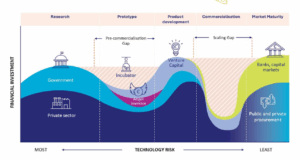
European Commission to fund Life Sciences Strategy using Cohesion Fund resources
The European Commission last week unveiled its Life Sciences Strategy, which aims to elevate Europe's biotechnology sector from third to first place globally by 2030, backed by an investment of €10bn. These funds are to be reallocated to food, agricultural, pharmaceutical and industrial biotechnology sectors.
Since the beginning of its current mandate, the Commission has made only limited reference to biotechnology. However, signs are increasing that Brussels now intends to make substantial progress in supporting this cross-sectoral platform technology, as the EU faces an expanding gap with China and the United States. EU Health Commissioner Olivier Várhelyi has announced that the EU Biotech Act will be brought forward by one year, and is likely to be presented alongside the EU Bioeconomy Strategy at the end of the year.
Building on the 2024 EU Strategy for Biotechnology and Biomanufacturing, the new Life Sciences Strategy extends beyond pharmaceutical biotechnology, adopting a broader scope comparable to strategies in the US and China. It includes biotechnological processes for food production, sustainable industrial biotechnology, raw material recovery, and materials science. The legislative underpinning for the €50bn initiative will be established through the soon-to-be-adopted pharmaceutical legislative package — including the Rare Medicines Act — the Bioeconomy Strategy, and the EU Biotech Act.
In the 30-page strategy document, the Commission has already earmarked specific funding: €100m for microbiome research, €300bn for biotech-related climate solutions via amended public procurement guidelines, and €250m to support the scaling of industrial biotechnology through EU critical infrastructure funding. Additional, unspecified sums are intended for increasing the number of cross-border, multi-centre clinical trials in Europe; advancing cell and gene therapies and AI-driven drug development; strengthening existing regional cluster structures; and linking regulatory processes in medical technology — such as companion diagnostics — more closely with medicinal product approvals.
A newly established Life Sciences Coordination Group will be tasked with preventing overlap between national and EU-level funding streams. The group will also act as a technology scout to identify and prioritise promising technologies. In parallel, EU regulations that currently slow the adoption of innovation are to be revised to enable the EU to close the innovation gap with China and the US.
The ambition is considerable, particularly in light of global public and private investment in pharmaceutical biotechnology — currently the most economically successful biotech application. In 2024 alone, public US funding for clinical trial-relevant initiatives totalled approximately US$55bn, while US companies invested around €71.3bn. In China, public funding reached US$15bn, with private investment totalling US$109.6bn. The EU allocated roughly €55bn in public funding. Chinese firms accounted for approximately 40% of all pharma licensing deals globally last year, having already surpassed US competitors in areas such as antibody-drug conjugates and bispecific antibodies by 2023. Data from the McKinsey Foundation suggest that emerging biotechnologies — including biomass and precision fermentation for food production — hold revenue potential of between €85bn and €125bn.
The strategy has been broadly welcomed by associations in biotechnology, research, and diagnostics. However, many stakeholders have emphasised that implementation will be the critical test. This raises the question of funding sources. As with the Clean Industrial Deal announced earlier this year — to be financed with €200bn — the Commission intends to draw funds from the EU’s €1.2tn Multiannual Financial Framework (MFF), whose allocation model is currently undergoing major revision, inspired by the Union’s COVID-19 recovery fund.
Austria, Belgium, France, Italy, Malta, Poland, Romania, Slovakia and Hungary are all currently running deficits large enough to warrant EU sanctions. One option to avoid asking Member States for additional contributions — the introduction of an EU-wide carbon tax — has been blocked in the Council since 2023. This leaves budgetary reallocation as the most viable path. Details will be outlined in the Commission’s budget proposal, due to be presented on 16 July.
Many elements of the current strategy were already contained in a Commission paper leaked in October. According to that document, funding will be redirected primarily from agricultural subsidies under the Common Agricultural Policy (CAP) — which have been cut by at least 15% and currently represent around 50% of average farm income — and from the Cohesion Fund, valued at €372bn. Each of these constitutes one third of the existing €1.079tn MFF budget. In addition, around €200m from the proposed European Competitiveness Fund (ECF) is to be allocated to the life sciences value chain via more than ten dedicated budget lines, such as the €94bn Horizon Europe programme, which will remain independent of the ECF.
While reductions to the CAP are politically sensitive — especially given the strength of the agricultural lobby in France — the €372bn allocated to cohesion funding may offer greater flexibility. According to the leaked document, these funds are to be consolidated into 27 national, reform-focused funding pools, targeting strategic sectors such as defence, artificial intelligence, and biotechnology. This approach would shift the emphasis away from supporting economic convergence between wealthier and less developed EU regions, in favour of providing the Commission with increased flexibility. Significant political resistance is anticipated.


 EC
EC Bendo/European Commission
Bendo/European Commission